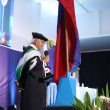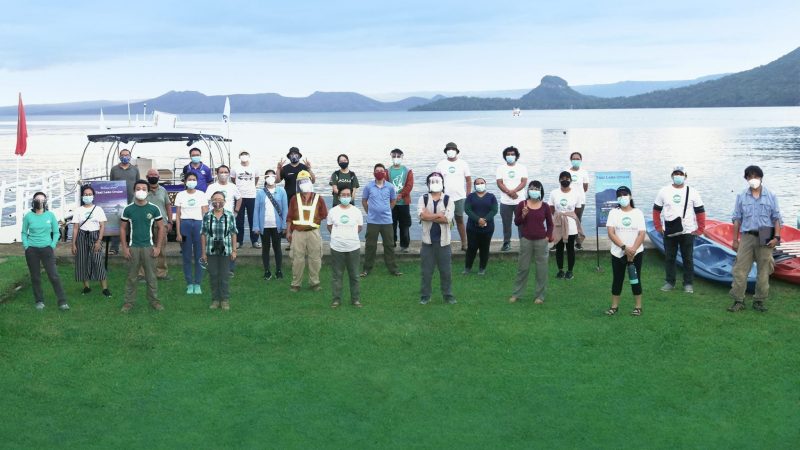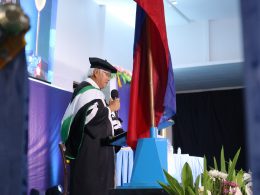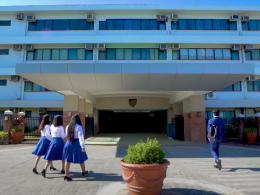Taal Volcano Island is a renowned tourist site often enjoyed as part of the landscape of Taal Lake or as a destination itself for those seeking outdoor adventure. But a new initiative from FAITH Colleges seeks to transform the island into a Nature Conservancy where people can also learn more about the volcano’s natural ecology—and in the process preserve the beauty of the site for generations to come.
In the early morning of 05 December 2020, a group of scientists from the Philippines’ top universities embarked on an 18-person expedition to Taal Volcano Island (TVI). Dubbed by the participants as Agham ng Bulkang Taal, these experts in the fields of biology and earth science set off to survey TVI and collect samples for laboratory research to better understand how life grows back in a volcano’s environs after an eruption. This was after the phreatomagmatic eruption of Taal Volcano on 12 January 2020 that displaced many of the local communities dependent upon the island’s biodiversity for their livelihood.
Organized amidst the COVID-19 pandemic, the expedition was arguably a matter of seizing an opportunity to align with circumstance; after all, science hardly waits for anyone.
More than this, the expedition was also the first project under FAITH Colleges’ initiative to transform TVI into a nature conservancy.
Taal Volcano Island Conservancy
The concept of a nature conservancy is not new, although it does represent an altogether different approach towards safeguarding the environment. A clean and habitable environment is typically viewed as a public good—while the environment is enjoyed by everyone, no single entity has an incentive to take responsibility over it.
As such, the traditional mechanism to achieve environmental preservation usually involves government regulation done in the public interest and often over public areas like forest reserves or biodiversity sites. Unfortunately, the success of such initiatives depends both on the quality of regulations and the ability of the state to implement them.
It is in this context that nature conservancies emerged as viable alternatives to regulatory approaches. At its core, a nature conservancy is a private entity that acquires or manages property for the purpose of preserving and maintaining the environment within that property. Some, like the Central Park Conservancy in New York, simply undertake to operate and raise funds for the continuous maintenance of park spaces in partnership with the government. Others, like the eponymously named Nature Conservancy of Canada, seek to acquire and secure land for purposes of conservation.
Nature as Laboratory
Located just 95 kilometers south of Manila, and with a magnificent view visible from Batangas and Cavite, the Taal Volcano Island (TVI) is a famed tourist site. With a rich history and an even richer biodiversity, its image is well engraved in the lives of local communities which mostly depended on the island and the lake for survival. As such, tremendous loss was felt when the eruption of Taal Volcano last year left the island covered in ash—and, at the time, uninhabitable.
Through a donation of 176 hectares of titled land within the Taal Volcano Island, FAITH Colleges now leads a multisectoral initiative to transform TVI into a nature conservancy space and, just as importantly, a living laboratory where the public at large can learn more about ecological and biodiversity conservation.
Under the recently organized FAITH Botanic Gardens Foundation (FBGF), the TVI Conservancy will immerse and educate stakeholders of how TVI functions as a nexus for various ecosystems in order to spark among them an interest in testing and furthering conservancy and sustainability plans. Thus, Agham ng Bulkang Taal is now the first major project under FBGF’s TVI Conservancy initiative.
Leading the series of expeditions were Dr. Lillian Rodriguez of the UP Terrestrial Research of Ecology and Evolution Laboratory (TREE Lab); Dr. Mario Aurelio, Director of the UP National Institute of Geological Sciences (NIGS); Dr. Alexander Young, Professorial Fellow of the UP Institute of Environmental Science and Meteorology (IESM); and UST College of Science Dean Dr. Rey Donne Papa. FAITH Botanic Gardens Foundation executive director Ed Coronel, who was responsible for putting together the expedition team, said that unique to the TVI Conservancy initiative is its sharp focus on the profiling of the island’s ecological recovery.
Early assessments from initial visits revealed that the island is already showing signs of life after a year in a desolated state. Visiting scientists noted the presence of at least 30 species of plants and 16 bird species, along with some predator insects and parasitoid species—all indicative of fast and positive ecological succession occurring on the island.
The ensuing scientific findings from the sustained trips and tests are envisioned to help create a living laboratory of ecological and diversity conservation for local students and researchers.
Further visits are scheduled to gather more baseline data that will inform stakeholders in charting future directions for conservancy efforts.
A Commitment to Responsible Stewardship
For many years, TVI’s ecosystem has provided surrounding communities with various resources for their sustenance. With its rich flora and fauna, the island has supplied fresh air, clean water, fuelwood, food, and livelihood to local dwellers. Even before the 2020 eruption, agencies have been calling for more stringent conservation measures to be put in place on the island, as some of its endemic species—the tawilis (Sardinella tawilis) for one—are now on the brink of extinction due to pollution and unwise fishing practices.
With an eye to the future, the TVI Conservancy initiative also aims to educate surrounding communities on strategic use of resources, proper land management, and wise governance of wildlife and ecosystems. Such efforts aim at restoring life in the island and amplifying the academe’s mobilizing capacity to work with local stakeholders in fostering a more solid understanding of long-term environmental protection. This also opens a sustainable pathway for data-driven tourism, a promising endeavor envisioned by FAITH Colleges president Saturnino G. Belen to provide livelihood opportunities to displaced families.
A Roadmap to Coordinated Recovery
The path to rebuilding TVI and successfully turning it into a nature conservancy area rests with the brave step of exploring possibilities for inclusion—connecting not only like-minded advocates for the environment, but also connecting those advocates with nature itself.
This means educating communities about sustainability. It means tapping natural, human, and social capital—strengthening capacity and leveraging skills and expertise among responsive, driven stakeholders. It means collectively taking on the challenge of renewing lives and communities by making sure ecosystems are nurtured and kept strong.
More than a resilient mindset, it is this science-guided, collaborative, coordinated approach that will truly ensure TVI’s long term sustainability.












